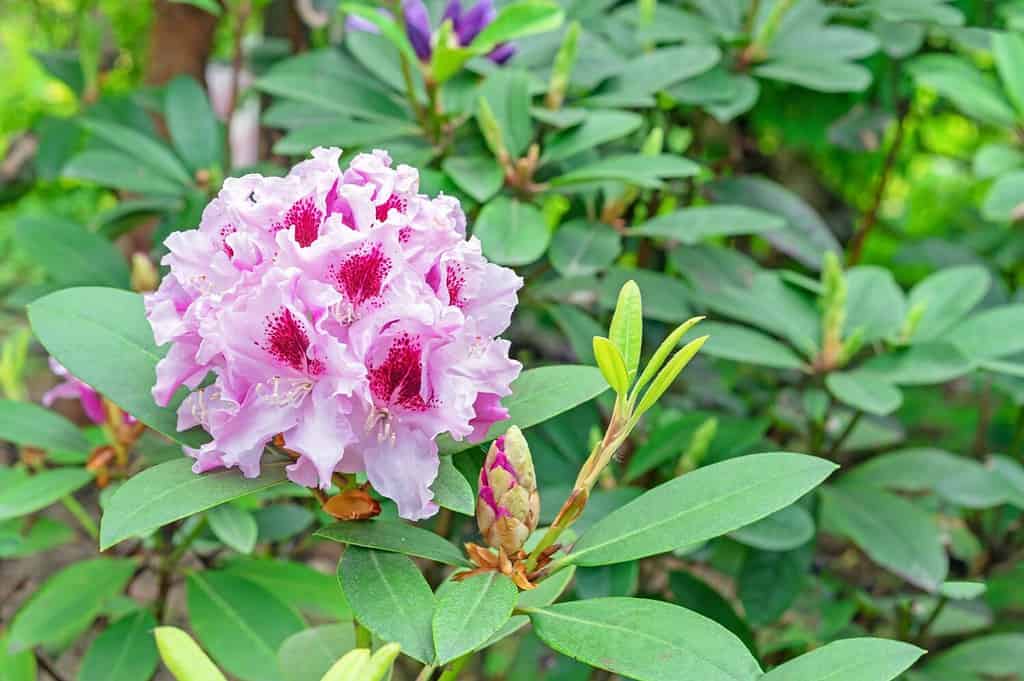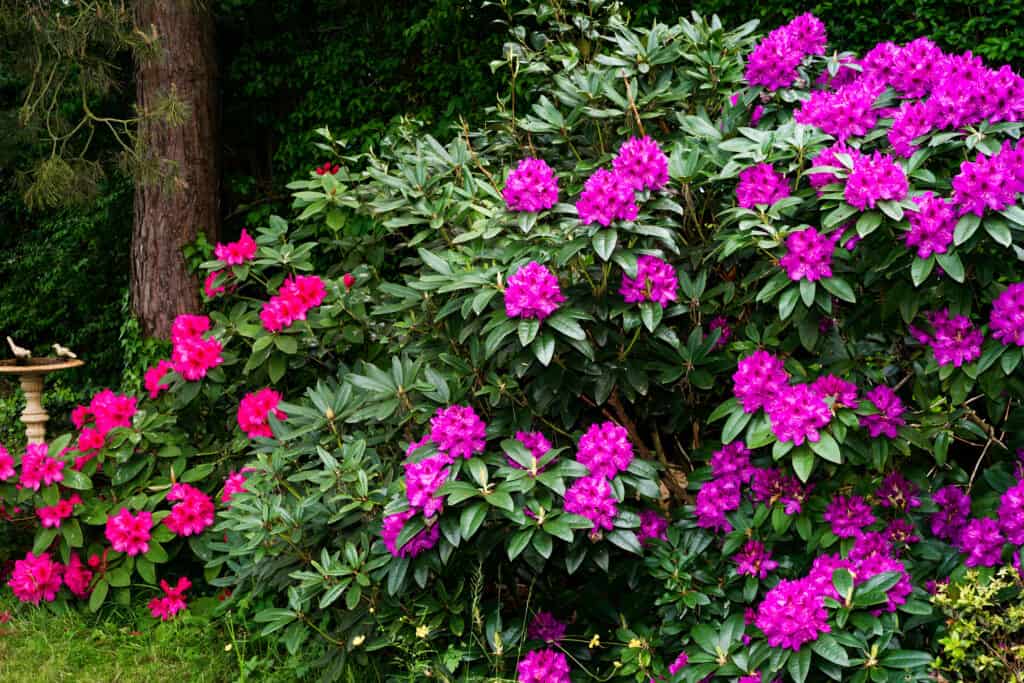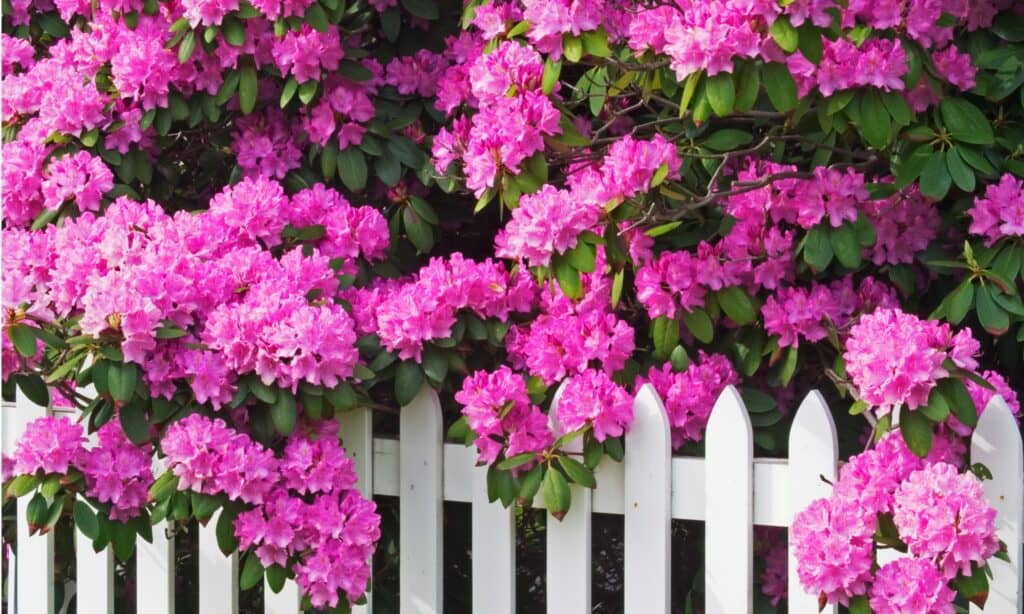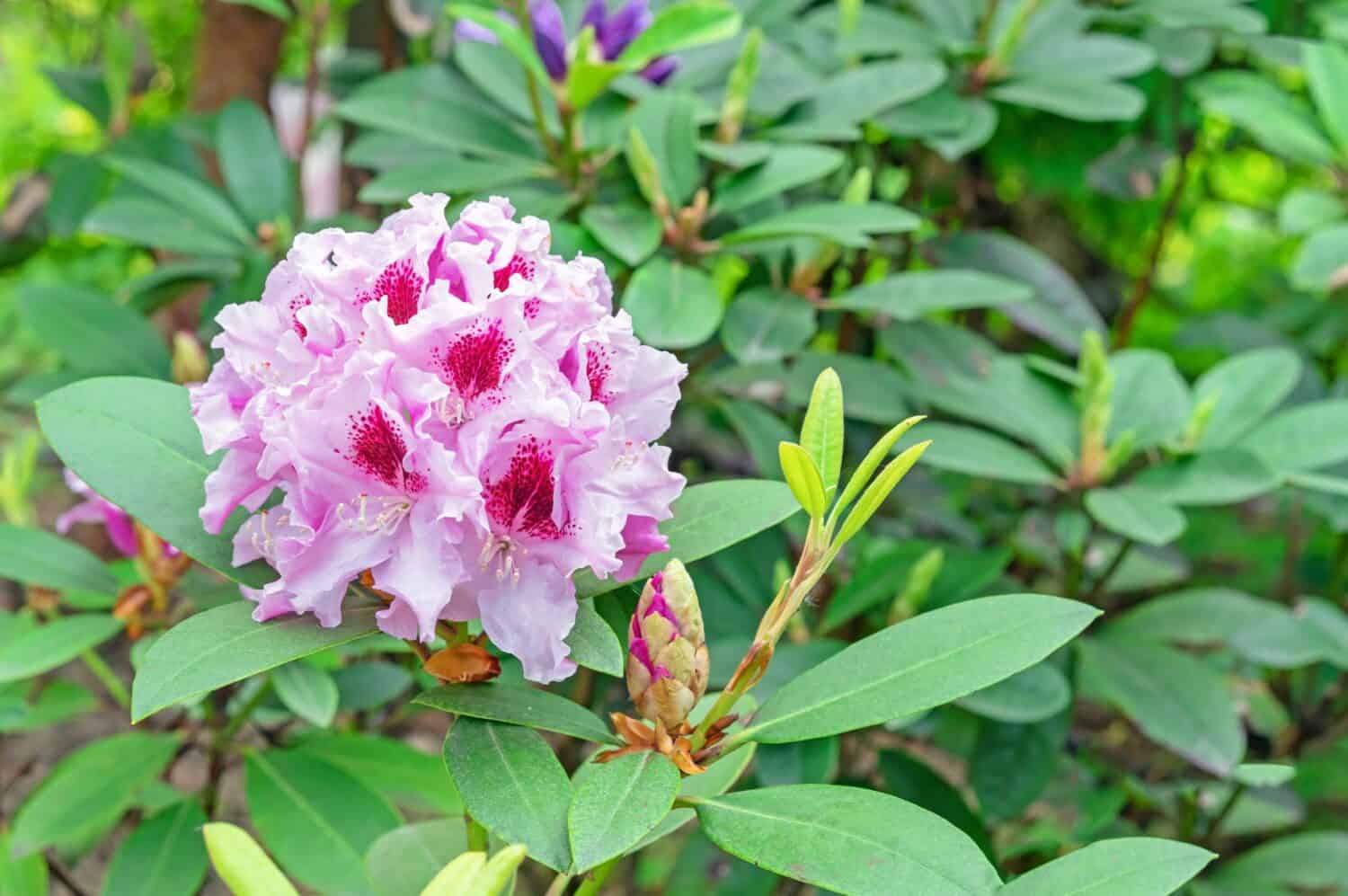There are over 1,200 species in the genus Rhododendron. There is much diversity in the species, both in size and color. Some species are low-growing ground cover, while others are trees that can grow over 100 feet tall. Flowers can come in shades of blues, purples, reds, oranges, yellows, and whites.
Flowers from the genus Rhododendron have always been trendy. For example, azaleas are one of the most common flowering shrubs in American gardens.
While azaleas are part of the rhododendron genus, not all rhododendrons are azaleas.
Exploring the Blooming Season of Rhododendrons and Its Beauty

Rhododendrons come in many colors and bloom through spring and summer.
©valemaxxx/Shutterstock.com
Rhododendrons are striking plants that mostly bloom from spring to summer. They do best in areas with primarily stable climates and need a considerable amount of rain.
The best places for growing rhododendrons are the coastal Pacific Northwest in North America and Britain and Scotland’s western coasts.
Peak Blooming Seasons: Discovering the Optimal Times for Rhododendrons Blooms in Different Hardiness Zones
According to The Old Farmer’s Almanac, rhododendrons can live in hardiness zones 3-11.
What are Hardiness Zones?
Hardiness zones are determined by the “average annual minimum winter temperature.”
The zones range from 1-13, divided by 10°F increments. They are further divided by 5°F increments. For example, zones one and two are separated by 10°F. Zone one is further divided into zones 1a and 1b, separated by 5°F. The lower the zone number, the colder a region is over the winter.
The “hardier” a plant is, the better it is at surviving harsh conditions. A plant that is more “tender” is more likely to die in extreme conditions.
What Hardiness Zones Can Rhododendrons Survive In?
Rhododendrons growing in zones 3-6 need some special care to stay alive.
Growers should plant them in full sun, where they will receive direct sunlight for at least six hours a day. Keeping them in full sun for this time prevents mildew from harming your flowers.
Plant them where they have some shelter from the wind. Too much dry, cold wind and shade can cause the buds to die.
Rhododendrons in zones 7-11 should grow where they get plenty of afternoon shade. This is especially important in very hot regions. Those that live in tropical regions can plant their Rhododendrons in full shade.
Optimal Bloom Time for Rhododendrons
Rhododendrons will bloom in early spring to early summer in all hardiness zones. The peak blooming season for most varieties is March to May.
Many varieties of Rhododendrons bloom at different times of the year.
For example, April Rose Rhododendrons typically bloom from April until May. PJM Elite Rhododendrons bloom in May. English Roseum Rhododendrons bloom in June. Weston’s Innocence Rhododendrons bloom from June to August.
Factors Influencing Bloom Time: Examining Environmental and Climatic Factors Affecting Rhododendrons Blooming

Some Rhododendrons are short ground cover, while others can grow to 100 feet tall.
©iStock.com/Jean-Luc Farges
Rhododendrons typically bloom in late spring to early summer. Some outside factors may shorten or eliminate bloom time.
Excess rain and rising temperatures are usually why rhododendrons stop blooming early.
Plus, keep in mind that rhododendrons will not continuously bloom every year. It’s normal for young or new rhododendrons to skip a season or two before they begin blooming. They need time to grow and get used to their new surroundings.
For some species, it’s completely normal not to bloom every year. Do some research on your variety and know what to expect before planting.
Extending Bloom Time: Tips and Techniques to Prolong and Enjoy Rhododendrons in Your Garden

Provide rhododendrons with love and care to extend their bloom time.
©iStock.com/dndavis
Rhododendrons are stunning flowers. So, it’s natural that you’ll want to extend their flowering time.
These beautiful plants are hardy and low-maintenance, so you don’t have to do much to get them to bloom. Still, you can give them tender, loving care to help them thrive.
The Best Place to Plant Rhododendrons
First, be sure to plant your rhododendrons in the right spot. Pick an area that is mostly stable throughout the seasons. The area should have protection from the wind and partial shade. Still, don’t forget they need a decent amount of sunlight for the best blooms.
Mulch and Compost
Use mulch around your plants to prevent weeds. It also helps your plants retain moisture during the hottest parts of the year. It’s as important to keep rhododendrons moist throughout the summer, even when they’ve stopped blooming.
Compost is essential for helping your rhododendrons thrive. Like mulch, compost helps the plants retain moisture. It also prevents them from getting too wet, which can cause root rot. Plus, it is a fantastic source of nutrients.
Fertilize Carefully
You can try fertilizing your rhododendrons during the spring or fall. Be careful when doing so.
Rhododendrons are prone to fertilizer burn. Pick a fertilizer designed for acid-loving plants.
Watch the pH of the Soil
Keep an eye on the pH, keeping it between 4.5 and 6. Rhododendrons love acidic soil.
Prune Before Blooming Season
One of the most essential parts of extending flowering time is keeping on top of pruning.
At the beginning of the season, prune any dead or damaged branches. The plant will then focus its energy on producing buds rather than trying to save its dead or dying “limbs.”
Plant Many Different Varieties
Lastly, consider adding different species of rhododendrons to your garden. Pick ones that bloom at different times so that your garden is blooming all summer long. There are even some varieties that can bloom in January and February in the right climates!
Preparing for Next Year
Besides extending this year’s blooming season, you’ll want to prepare for the next season. “
Deadhead” your rhododendron by cutting the flower off just below the blossom once it’s died. Doing so encourages the plant to focus its energy on creating next year’s buds.
Thank you for reading! Have some feedback for us? Contact the AZ Animals editorial team.








